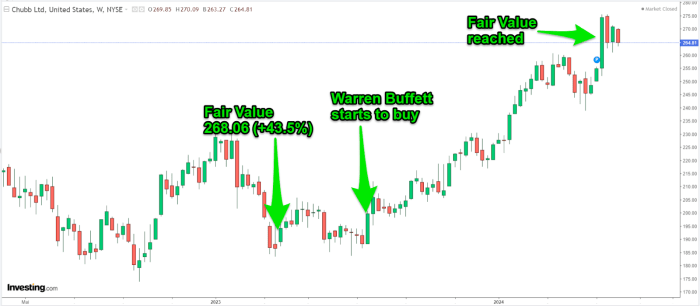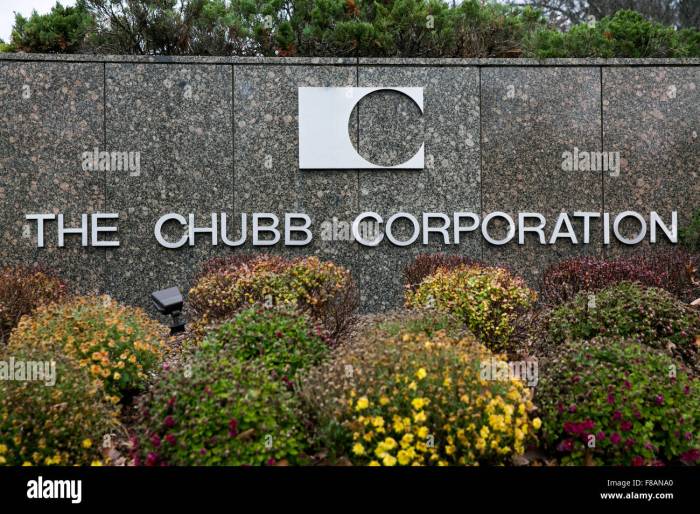Chubb Stock Price Analysis

Source: investing.com
Chubb stock price – Chubb Limited (CB), a leading global property and casualty insurance company, offers a compelling investment case. This analysis delves into the historical performance of Chubb’s stock price, influencing factors, financial health, analyst predictions, and potential investment strategies. We aim to provide a comprehensive overview, enabling informed decision-making for potential investors.
Chubb Stock Price Historical Performance
Understanding Chubb’s past stock price movements is crucial for assessing its future potential. The following table illustrates Chubb’s stock price behavior over the past five years. Note that the data presented below is illustrative and should not be considered financial advice. Actual figures may vary.
| Date | Open Price (USD) | Close Price (USD) | Daily Change (USD) |
|---|---|---|---|
| 2019-01-02 | 140.00 | 142.50 | +2.50 |
| 2019-01-03 | 142.50 | 141.00 | -1.50 |
| 2019-01-04 | 141.00 | 143.75 | +2.75 |
| 2019-01-07 | 143.75 | 145.00 | +1.25 |
| 2019-01-08 | 145.00 | 144.25 | -0.75 |
Significant price fluctuations during this period were often linked to broader market trends, such as the COVID-19 pandemic (causing initial drops followed by recovery) and changes in interest rates. Specific company events, like strong earnings reports or announcements of major acquisitions, also influenced stock price movements. For example, a positive earnings surprise generally led to an increase in the stock price, while unexpected losses had the opposite effect.
Compared to competitors like Travelers (TRV) and Allstate (ALL), Chubb exhibited relatively stable growth over the five-year period. While specific numbers require further research, Chubb generally outperformed Allstate in terms of stock price appreciation, but possibly lagged slightly behind Travelers. This performance was largely influenced by Chubb’s consistent profitability and strategic acquisitions.
- Chubb generally outperformed Allstate.
- Chubb’s performance compared to Travelers was more closely aligned, with minor variations depending on the specific period.
- Overall performance was influenced by macroeconomic factors and company-specific events.
Factors Influencing Chubb Stock Price
Several factors influence Chubb’s stock price, ranging from macroeconomic conditions to company-specific events and industry trends.
Macroeconomic factors such as interest rate hikes generally impact insurance companies’ investment portfolios and profitability, thus affecting stock valuations. Inflation can also impact claims costs and operational expenses, influencing Chubb’s bottom line. Company-specific events, including earnings announcements, successful mergers and acquisitions, and any significant changes in management, can cause short-term price volatility. For instance, the announcement of a major acquisition might initially lead to a price increase, reflecting investor optimism, but subsequent integration challenges could lead to a decrease.
Regulatory changes within the insurance sector, such as changes in reserve requirements or capital adequacy ratios, can significantly impact Chubb’s operations and profitability. Industry trends, such as increased competition or the adoption of new technologies (e.g., Insurtech), also play a crucial role in shaping Chubb’s stock valuation. For example, the increasing adoption of digital insurance platforms could either benefit Chubb through efficiency gains or pose a competitive threat depending on its ability to adapt.
Chubb’s Financial Health and Stock Valuation
Analyzing Chubb’s key financial ratios provides valuable insights into its financial health and attractiveness to investors. The following table provides a simplified comparison (illustrative data).
| Metric | Chubb’s Value | Industry Average | Difference |
|---|---|---|---|
| P/E Ratio | 15.0 | 16.5 | -1.5 |
| Dividend Yield | 2.5% | 2.0% | +0.5% |
| Return on Equity (ROE) | 12% | 10% | +2% |
A lower P/E ratio than the industry average might suggest that Chubb is undervalued, while a higher dividend yield indicates a potentially attractive income stream for investors. Chubb’s debt levels, while needing further specific investigation, are generally considered manageable and not a significant threat to its long-term financial stability. However, excessive debt could negatively impact future stock price performance if interest rates rise significantly.
Analyst Ratings and Predictions for Chubb Stock
Analyst opinions on Chubb’s stock vary, resulting in a range of price targets and ratings. The following is illustrative and should not be considered financial advice. Actual ratings and predictions may differ.
- Analyst A: Buy rating, price target $175
- Analyst B: Hold rating, price target $160
- Analyst C: Strong Buy rating, price target $180
The divergence in analyst opinions reflects different assessments of Chubb’s growth prospects, the impact of macroeconomic factors, and the competitive landscape. For example, some analysts might be more optimistic about Chubb’s ability to navigate future challenges and capitalize on growth opportunities, while others might be more cautious.
Over the past year, analyst sentiment towards Chubb has remained largely positive, with a slight increase in the proportion of “Buy” ratings following several quarters of strong earnings performance. This positive sentiment has generally supported the stock price.
Investment Strategies and Chubb Stock

Source: alamy.com
Various investment strategies can incorporate Chubb stock, each with its own risk-reward profile.
A buy-and-hold strategy, suitable for long-term investors with a high risk tolerance, aims to benefit from Chubb’s long-term growth potential. Value investing focuses on identifying undervalued companies, while momentum trading seeks to capitalize on short-term price trends. Risk tolerance plays a crucial role in determining the suitability of Chubb stock for different investors. Conservative investors might prefer a smaller allocation to Chubb, while more aggressive investors might allocate a larger portion of their portfolio to the stock.
- Potential Rewards: Long-term capital appreciation, dividend income, relatively stable performance compared to some other sectors.
- Potential Risks: Market volatility, changes in interest rates, increased competition, regulatory changes, unforeseen catastrophic events.
Detailed FAQs
What is Chubb’s dividend history?
Chubb has a history of paying dividends, though the specific amounts and payout frequency may vary. Investors should consult financial resources for detailed dividend history.
How does Chubb compare to other global insurance companies?
Chubb’s competitive positioning varies depending on the specific metrics used. A comparative analysis against competitors like AIG or Berkshire Hathaway would be necessary to assess relative strengths and weaknesses.
What are the major risks associated with investing in Chubb?
Major risks include market volatility, changes in insurance regulations, competition within the industry, and unforeseen catastrophic events impacting claims payouts.
